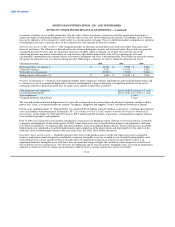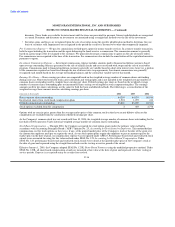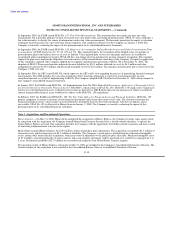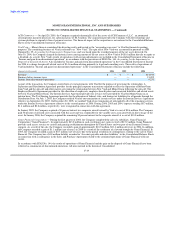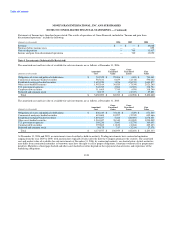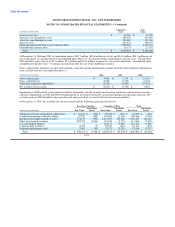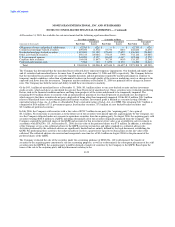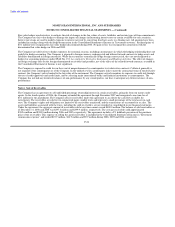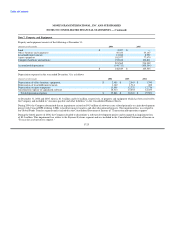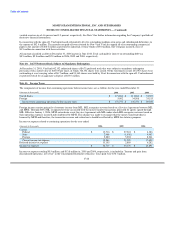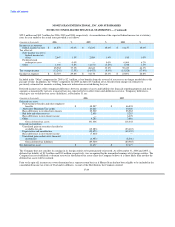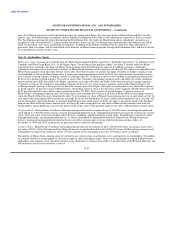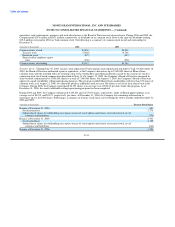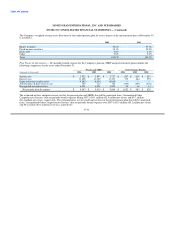MoneyGram 2006 Annual Report Download - page 81
Download and view the complete annual report
Please find page 81 of the 2006 MoneyGram annual report below. You can navigate through the pages in the report by either clicking on the pages listed below, or by using the keyword search tool below to find specific information within the annual report.
Table of Contents
MONEYGRAM INTERNATIONAL, INC. AND SUBSIDIARIES
NOTES TO CONSOLIDATED FINANCIAL STATEMENTS — (Continued)
Fair value hedges use derivatives to mitigate the risk of changes in the fair values of assets, liabilities and certain types of firm commitments.
The Company uses fair value hedges to manage the impact of changes in fluctuating interest rates on certain available-for-sale securities.
Interest rate swaps are used to modify exposure to interest rate risk by converting fixed rate assets to a floating rate. All amounts have been
included in earnings along with the hedged transaction in the Consolidated Statement of Income in "Investment revenue." Realized gains of
$0.1 million were recognized on fair value hedges discontinued during 2004. No gain or loss was recognized in connection with the
discontinued fair value hedges in 2006 and 2005.
The Company uses derivatives to hedge exposures for economic reasons, including circumstances in which the hedging relationship does not
qualify for hedge accounting. The Company is exposed to foreign currency exchange risk and utilizes forward contracts to hedge assets and
liabilities denominated in foreign currencies. While these contracts economically hedge foreign currency risk, they are not designated as
hedges for accounting purposes under SFAS No. 133, Accounting for Derivative Instruments and Hedging Activities. The effect of changes
in foreign exchange rates on the foreign-denominated receivables and payables, net of the effect of the related forward contracts, recorded in
the Consolidated Statement of Income is not significant.
The Company is exposed to credit loss in the event of nonperformance by counterparties to its derivative contracts. Collateral generally is
not required of the counterparties or of the Company. In the unlikely event a counterparty fails to meet the contractual terms of the derivative
contract, the Company's risk is limited to the fair value of the instrument. The Company actively monitors its exposure to credit risk through
the use of credit approvals and credit limits, and by selecting major international banks and financial institutions as counterparties. The
Company has not had any historical instances of non-performance by any counterparties, nor does it anticipate any future instances of non-
performance.
Note 6. Sale of Receivables
The Company has an agreement to sell undivided percentage ownership interests in certain receivables, primarily from our money order
agents. In the fourth quarter of 2006, the Company extended the agreement through December 2007 and recognized a one-time fee of
$0.1 million for the amendment. The Company sells its receivables under this agreement to accelerate the cash flow available for
investments. The receivables are sold to two commercial paper conduit trusts and represent a small percentage of the total assets in each
trust. The Company's rights and obligations are limited to the receivables transferred, and the transactions are accounted for as sales. The
assets and liabilities associated with the trusts, including the sold receivables, are not recorded or consolidated in our financial statements.
Under the agreement, the aggregate amount of receivables sold at any time cannot exceed $400.0 million. The balance of sold receivables as
of December 31, 2006 and 2005 was $297.6 million and $299.9 million, respectively. The average receivables sold approximated
$382.6 million and $389.8 million during 2006 and 2005, respectively. The agreement includes a 5% holdback provision of the purchase
price of the receivables. This expense of selling the agent receivables is included in the Consolidated Statement of Income in "Investment
commissions expense" and totaled $23.9 million, $16.9 million and $9.9 million during 2006, 2005 and 2004, respectively.
F-24


